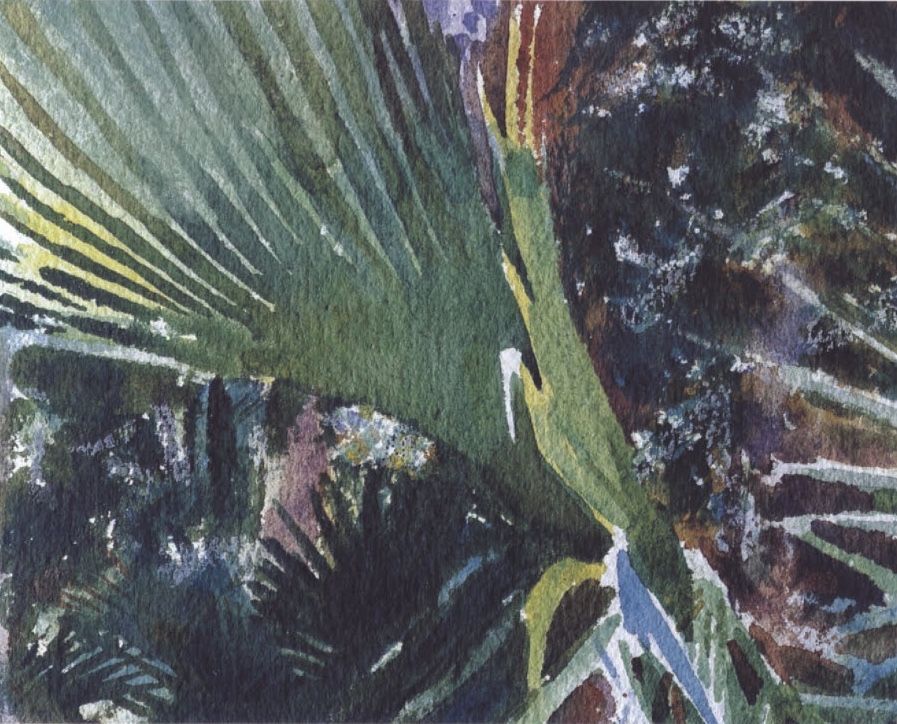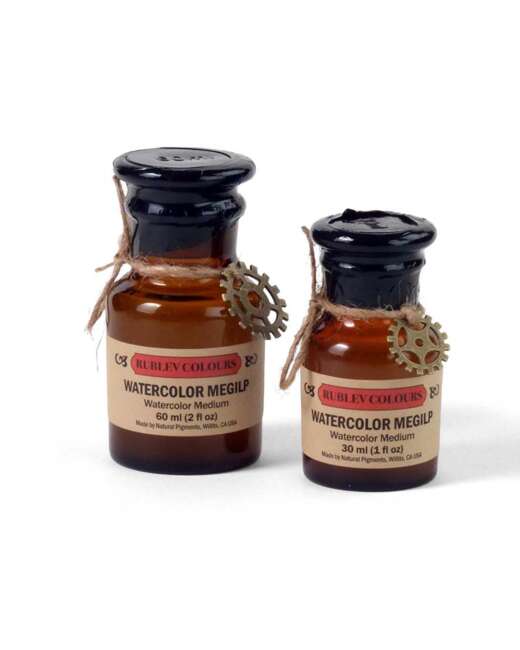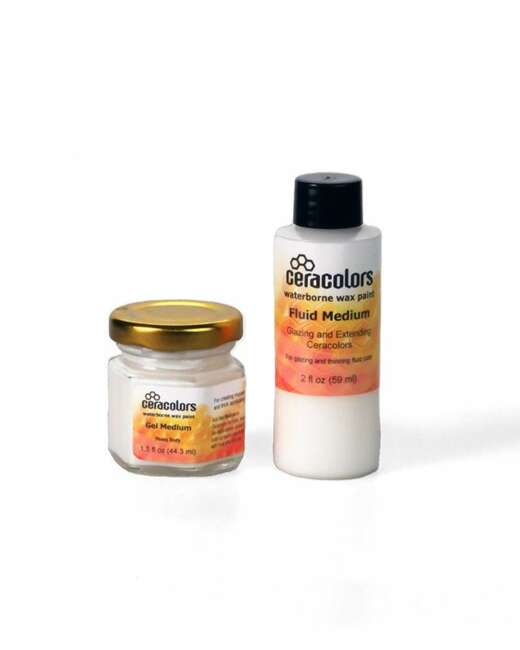
Detail, Palmettos, John Singer Sargent, watercolor on paper. The texture of the dark green paint has been modified with watercolor megilp. The distinct glossiness of the watercolor medium is seen, for example, in the strokes of burnt umber, Vandyke brown, and the deep greens that have dried with a shiny rim.
Did watercolorists of the 18th and 19th centuries use mediums to brush and manipulate watercolors? The evidence shows that they handled their colors differently from contemporary artists today. Here are some historical references on the use of watercolor mediums by British watercolorists of the 18th and 19th centuries:
Watercolor Megilp
The colours to be used for this purpose are not transparent ones, but must possess a degree of opacity and turbidness; of all others, none can surpass, for near trees, Indian Yellow, Burnt Sienna, and Indigo; the Indian Yellow being the color that gives the opacity. To prevent the colours flowing, a little water-colour megilp may be used with them. This vehicle completely resembles, in its effects, those of oil painting, and can be put, while wet, into any form. A flat sable brush is valuable for working it, and the trees may be treated just in the same manner as in oil painting. Lights can be taken out most delightfully and very crisply. As the megilp causes the colour to dry rather dull, glazings of transparent colours are necessary; and it is better to put them on lightly two or three times, than to make them strong enough at once. If any of the lights be very brilliant, water must be put upon the shape, the blotting paper applied, and the spot then rubbed briskly with India rubber; this will regain the white paper, which will receive any kind of pure washes with great brilliancy. Too much attention cannot be given to the stems and branches; as, if they are not well managed, the tree will be entirely spoiled. They must always appear to pass behind the foliage, beginning again of a proper thickness when they reappear at the top of it. We must be able, in imagination, to trace the whole ramification, from the top to the bottom, through all the intricacies of leafage. All the shadows are to be washed on very broadly at first, leaving the markings for the finish. When the character of the bark is rough, great care must be taken not to cut up the breadth of light by too many catching lines; for, of this, hardness would be the sure consequence. Separate studies of the trunks, where they bear any decided peculiarity, will be found extremely useful.
Source
Aaron Edwin Penley (1850) A System of Water-Colour Painting. Being a Complete Exposition of the Present Advanced State of the Art, As Exhibited in the Works of the Modern Water-Colour School. London: Winsor & Newton, 1850. pp. 45–46.
In Chapter III., Section III., on “the Handling of the Brush,” directions have been given to use in the first attempts a neutral tint, so that the pupil, when employed in the practice of colour, may not have to encounter all the difficulties at the same time. In concluding this portion of the work, however, it may be as well to point out that there are varieties in the form of brushes which greatly facilitate the introduction of certain shapes and touches. Thus a large round sable in an eagle or swan quill may suffice for the broad and flat tints at the beginning; but it should not be so large that it cannot be used to give the outside terminations of the foliage with its true character, as this is generally better done at once, although light and separated sprays may be added at the conclusion. A flat and rather short sable is also used; and with it and some of the more opaque pigments, great variety of touch and form can be obtained; when the colour is thick, or gum or megilp is used, much the same effect is produced as is obtained in oil. The water-colour painter cannot fail to regard as a valuable power the facility of putting on the highest lights possessed by the painter in oil; but notwithstanding this, he should avoid as much as possible the employment of opaque body-colour, as, although it may add to the force, will certainly detract from the transparency of the work.
Source
George Barnard (1861) The Theory and Practice of Landscape Painting in Water-Colours: Illustrated By a Series of Twenty-Six Drawings and Diagrams in Colours, and Numerous Woodcuts. 7th Edition. Routledge, Warne and Routledge, 1861. p. 172.
References in literature to watercolor megilp included its use as a varnish to protect fugitive pigments, '...book of Art of Illumination recommend the colour to be coated with water-colour megilp, when the tint will be fixed.' (C.F.T., 1866) It is described as 'a good medium to use. It can be got at any art shop,' by Charles Dickens in Household Words. (Dickens, 1883)
Further Reading
Henry Montanell Lucien (1860) Hints on Illuminating, With an Essay on the Art of Ornamenting in Gold or Metals. 3rd Edition. J. Barnard, 1860. p. 17.
C.F.T. (1866) Notes and Queries: A Medium of Inter-Communication for Literary Men, General Readers, Etc. (3rd Series, Vol. 10, July–December 1866) London: Oxford University Press, 1866. p. 153.
Charles Dickens (1883) Household Words. Bradbury & Evans, 1883. p. 78.
Gum Tragacanth
GUM TRAGACANTH. Both glutinous and dull watercolor megilp is made from this. By its introduction the colors may be applied thickly, after the manner of Oil Painting, as it prevents their flowing. Trees are sometimes painted by the addition of a little megilp.
Source
Susan E. Strickler (1987) American Traditions in Watercolor: The Worcester Art Museum Collection. Worcester Art Museum, 1987. p. 63.
Gum-Water
If greater transparency is required, the effect will be greatly heightened by passing a little gum water, or other vehicle, over the strongest parts; this will cause the colours to shine out with much force, and bring them completely in advance. Judiciously employed, there is nothing that is calculated to give so much transparency and force to our work. (Penley, p. 55.)
Source
Aaron Edwin Penley (1850) A System of Water-Colour Painting. Being a Complete Exposition of the Present Advanced State of the Art, As Exhibited in the Works of the Modern Water-Colour School. London: Winsor & Newton, 1850. p. 55.













